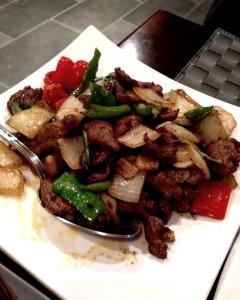
Cumin lamb at Shanghai Lounge
I rarely dine at an Asian restaurant when I’m in the States for the simple reason that, however authentic the place claims to be, it is no comparison to a restaurant in Asia. Nonetheless, I have still tried a handful of Asian places, and found that I was pleasantly surprised, once.
Either by choice or by chance, the Asian restaurants I’ve visited are all limited to one cuisine type — in other words, it was either Japanese, Chinese, Vietnamese or of some other country, but never a mixture. I do not believe in fusion food, especially not in the case of Chinese and Japanese cuisine. I have enough knowledge and experience of both to know that there does not exist asingle Chinese or Japanese cuisine. Each can be divided into numerous branches of very distinct cuisine types. In the case of Chinese gourmet, it can be categorized by region — I personally would never try a fried scorpion/spider/cocoon as they do in northern China. Japanese cuisine, on the other hand, includes so much more than just sushi: okonomiyaki, takoyaki, yakitori, to name but a tip of the iceberg. This is not just about American representations of Asian cuisine: Now that I am in Barcelona, I have realized that Catalan cuisine is different from tapas, which is also different from paellas. Therefore, I have always had trouble keeping my derisive snort in check upon seeing fusion restaurants.
Let me start with the places that I would not recommend. ShopHouse belongs to the said fusion category; it also belongs to the same company as Chipotle. While I am somewhat satisfied with Chipotle, ShopHouse turned out to be a huge disappointment: the dishes taste bland and unmemorable. Daikaya, on the other hand, did aim to provide only Japanese food, in particular, ramen. As a ramen lover, I have to say, this is just nothow an authentic Japanese ramen should be. While the restaurant claims to import their noodles from Japanese, in reality, the noodles appeared more Korean than Japanese. The soup base had a decent taste — but just not how ramen soup should be. Instead of miso, it tasted like a bowl of chicken broth with too much soy sauce. Overall, it was edible, but in no way authentic.
In a slightly brighter note, the Shanghai Lounge not far from campus proved to be decent enough. Curiously, the owner told me that whereas before it was indeed a Shanghainese restaurant, it has now changed into a place specializing in Sichuan cuisine. Nonetheless, the specialty Shanghai Steamed Pork Bun has been kept on the menu and proves to be a delicious, and authentic, treat. The cumin lamb and the Happy Eggplant were not really Sichuan dishes; or if they were, the spiciness had been greatly modified. Both dishes were rather tasty and authentic to be honest: they resembled the dishes in a random little restaurant in Shanghai. The only difference being, the dishes are sold three to even six times more expensive in the U.S.
So, what is the restaurant that surprised me? Pho 75, the hidden gem in Rosslyn. As simple and plain as the restaurant is, it has acquired a reputation of great pho. The pricing is not cheap, but the portion sizes are very generous — a regular bowl of pho was more than enough for me. I chose Choice 1, a combination of meat, which included raw beef. The pieces arrived still quite red, whetting my appetite even more. After the first few trials, I was left speechless: The rumors are true! These are as good as a bowl of pho can be. The thin noodles themselves were very authentic and were cooked to perfection: just a tiny trace of chewiness and not at all overly soft. The beef tasted so tender — not melt-in-your-mouth tender, but the right level of chewiness for a soup-based bowl of pho. Granted, I am not yet an expert in Vietnamese cuisine, but as an amateur, I was left content and convinced.
Despite the good impression of Pho 75, overall, I am still not particularly enthusiastic about the Asian cuisine in D.C. — well, except for Indian cuisine, but that’s for another day.
Yiwen Hu is a rising sophomore in the School of Foreign Service. Tastes of the District appears every other Wednesday at thehoya.com








